#kimonadress
Explore tagged Tumblr posts
Text
To identify an authentic Barong Tagalog, there are several key factors to consider, including the fabric, embroidery, construction, and overall craftsmanship. Here’s a breakdown:
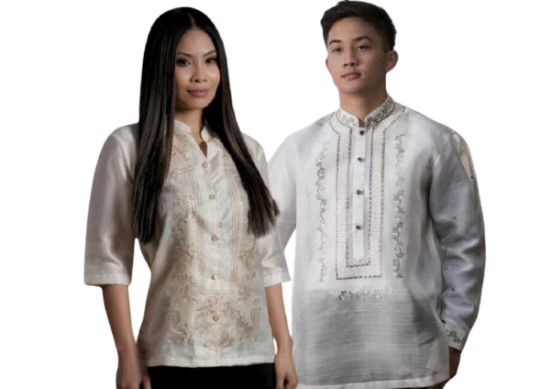
1. Fabric
Piña (Pineapple Fiber): Traditional Barong Tagalog is often made from piña, a fabric made from the fibers of pineapple leaves. This fabric is delicate, translucent, and has a natural sheen. It’s one of the finest materials and usually very expensive.
Jusi (Silk and Banana Fiber): Another fabric used for Barong Tagalog, made from silk and banana fibers, with a more subtle sheen than piña.
Other Fabrics: Modern Barongs might use synthetic or cotton blends, but these are generally less expensive and might not have the same luxurious feel as piña or jusi.
Feel: The authentic fabric should feel lightweight, breathable, and have a slight crispness to it. If it feels heavy or too smooth, it might not be authentic.
2. Embroidery
Hand-Embroidery: Traditionally, Barong Tagalog features hand-embroidered designs, especially on the chest area. These intricate patterns are typically floral or nature-inspired. You can often see slight irregularities in hand-embroidered designs, but they should be well-executed.
Machine-Embroidery: Mass-produced Barongs might use machine embroidery, which can look neat but lacks the unique imperfections and craftsmanship of hand-embroidery. Check if the stitching is uniform and too perfect; it might indicate machine work.
3. Construction and Fit
Collar and Placket: Authentic Barongs have a stiff, structured collar and a front placket. The buttons are typically made from mother-of-pearl or wood, rather than plastic.
Button Placement: The Barong Tagalog usually has a row of buttons down the front, but the placket should be smooth without visible stitching. In some modern versions, there might be side slits for ease of movement.
Overall Fit: Barongs are designed to be loose-fitting and lightweight, often worn untucked, though they should not look sloppy. It should feel comfortable, especially in warm weather.
4. Color and Dye
Colors: Authentic Barongs are often in light, neutral tones such as white, cream, ivory, or pale yellow. Bright, overly saturated colors could indicate a cheaper version or one that’s mass-produced.
Dyeing Process: The colors should be consistent and the dye should not fade or bleed easily. The fabric itself should hold its color well over time.
5. Label and Origin
Craftsmanship: Many authentic Barong Tagalog pieces are made in the Philippines, especially in regions like Aklan, Iloilo, and Bacolod, where piña fabric is woven. You might find a label from these areas or from well-known Filipino designers.
Price: Authentic Barongs made from piña or jusi can be expensive due to the labor-intensive process involved in crafting them. Be cautious of Barongs priced too low, as they may not be made from authentic materials or may lack attention to detail in the embroidery and construction.
6. Authenticity Check
Texture Test: Run your hand along the fabric. Genuine piña or jusi should feel slightly rough yet smooth, not overly soft or slick.
Water Test: If you’re unsure about the fabric, gently wet a small section of it. Piña tends to hold its shape better when wet and will dry with a slight crispness. Synthetic fabrics might wrinkle or lose their shape.
By checking these details, you can be more confident in identifying an authentic Barong Tagalog.
#barong tagalog#philippines#barong#pinoy#philippines fashion#barongtagalog#barongtagalogforwomen#womensfashion#shopping#barongs#Custommadebarongtagalog#filipinopride#kimonadress#pinoyshoppingonline
4 notes
·
View notes
Text
Sharing personal narratives during Filipino American History Month is a powerful way to honor and celebrate Filipino heritage while also fostering a deeper connection to one’s roots and identity. Here are some meaningful approaches to sharing your Filipino American heritage:

1. Family Stories and Traditions
Highlight Generational Journeys: Share the stories of your ancestors or parents who immigrated to the U.S. What motivated them to leave the Philippines, and what challenges did they face in adapting to a new culture? Exploring these journeys allows others to appreciate the resilience of Filipino immigrants.
Cultural Traditions: Discuss the customs and traditions that have been passed down through your family, such as celebrations of Pasko (Christmas), fiestas, or rituals like Simbang Gabi. Share how your family balances Filipino traditions with life in America.
2. Struggles and Achievements as a Filipino American
Navigating Dual Identities: Many Filipino Americans grow up balancing two cultures—American and Filipino. Sharing how you’ve navigated this identity can resonate with others who may have similar experiences of being bicultural.
Facing Discrimination and Finding Empowerment: Talk about any challenges you’ve faced, such as racial discrimination or feeling like an outsider. Sharing how you overcame these struggles, found empowerment, or connected with the Filipino American community can be inspiring.
3. The Role of Filipino Values
Values like Bayanihan and Kapwa: Filipino culture is deeply rooted in values like bayanihan (community spirit) and kapwa (shared humanity). Share stories of how these values were instilled in you and how they have influenced your life in America. Have you seen these values in action in your own community?
Respect for Elders: The concept of utang na loob (debt of gratitude) and pakikisama (getting along with others) are strong values in Filipino culture. Reflecting on how these values have shaped your relationships with family and friends can open up meaningful dialogue.
4. Food as a Cultural Bridge
Exploring Filipino Cuisine: Food is one of the most accessible ways to share heritage. Talk about the dishes your family loves to cook or the meals you grew up with, such as adobo, lumpia, sinigang, or lechon. Hosting a gathering or sharing recipes can be a fun and engaging way to introduce others to Filipino culture.
Food and Storytelling: Food often serves as a bridge to deeper conversations. Share a story about a particular dish, its significance, and how it connects you to your heritage.
5. Contribution to American Society
Highlight Filipino American Achievements: Whether it’s sharing the stories of Filipino labor leaders like Larry Itliong or the contributions of Filipino World War II veterans, remind others of the long history of Filipino Americans in shaping the country.
Your Own Impact: Discuss your personal achievements and how your Filipino heritage has influenced your work or contributions to society. Whether you are involved in education, healthcare, technology, or any field, your story adds to the rich tapestry of Filipino American history.
6. The Power of Art and Music
Creative Expression: If you are an artist, musician, or writer, use your platform to express your heritage. Through dance (such as Tinikling or Binasuan), music, poetry, or visual art, you can share aspects of Filipino culture while connecting with diverse audiences.
Filipino American Artists: Reflect on the work of Filipino American creatives who have inspired you, from authors like Carlos Bulosan to contemporary filmmakers and musicians.
7. Engaging in Social Media and Public Talks
Social Media Campaigns: Use social media to share your narrative with a broader audience. Creating posts, videos, or blogs during Filipino American History Month can help educate others on the rich diversity of the Filipino American experience.
Speaking at Community Events: Volunteer to speak at schools, universities, or community centers. Sharing your story publicly can inspire others to reflect on their own heritage and embrace their cultural identity.
8. Connecting with Filipino American Communities
Attending Cultural Events: Participate in or organize events within your local Filipino American community. Storytelling circles, cultural festivals, or panel discussions are great ways to share your personal narrative and learn from others.
Mentorship and Youth Involvement: Sharing your story with younger generations can be impactful. Encourage young Filipino Americans to be proud of their heritage and pass on the importance of understanding their roots.
By sharing your personal narratives, you are contributing to the broader Filipino American story and helping preserve the legacy of a resilient and dynamic community. It’s also a way to celebrate identity, create solidarity, and ensure that the unique experiences of Filipino Americans are not forgotten.
#barongtagalog#philippines#barongs#philippine culture#custommadebarongtagalog#filipinopride#madeinthephilippines#filipinoculture#filipinowedding#pinoy#filipinostyle#pinoyshoppingonline#Custommadebarongtagalog#pinoyshopping#kimonadress#FilipinoWeddingDress
2 notes
·
View notes
Photo

Buy baby_blue_kimona_5264_b
We pride in offering the best range of dresses and the kind of kimona dress that make the difference dressed and well dressed visit Barongs R Us
0 notes
Text


There's nothing like a beautiful Alampay to match your Filipiniana! Matching your Filipinianas with an Alampay of your choice projects beauty and elegance, empowering every woman with a unique sense of style and a connection to her roots.
#barong tagalog#philippines#barong#pinoy#philippines fashion#barongtagalog#barongtagalogforwomen#womensfashion#shopping#barongs#fhilipina#alampy#alampay barong tagalog#kimonadress#womensbarong
8 notes
·
View notes
Text
Filipino traditional costumes are diverse and vary across different regions of the Philippines. Here are some examples:
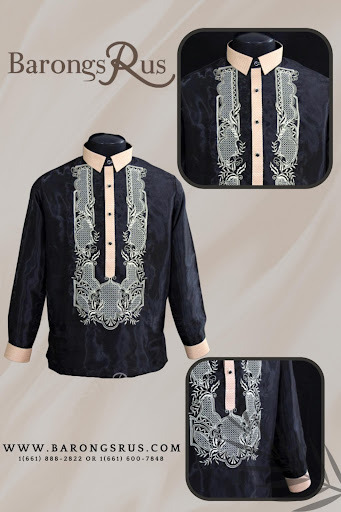
Barong Tagalog: The Barong Tagalog is a formal shirt-like garment for men, often worn at special occasions and events. It is made from lightweight fabrics like piña (pineapple fibers) or jusi (banana fibers) and is known for its intricate embroidery. The Barong Tagalog is typically worn untucked over a plain undershirt.
Maria Clara Dress: Named after a character in Dr. Jose Rizal’s novel “Noli Me Tangere,” the Maria Clara dress is a traditional gown for women. It features a flowing skirt and butterfly sleeves, often made from lightweight fabrics like piña or jusi. It’s commonly worn during formal events and occasions.
Terno: The terno is an iconic Filipino formal gown for women. It features a distinctive butterfly sleeve, which can vary in size and design. The terno is often worn at prestigious events and was even popularized by former First Lady Imelda Marcos.
Ilocano Attire: In the northern region of Ilocos, both men and women wear traditional outfits. Men wear a striped woven shirt called “inabel” or “baro’t saya,” while women wear a wrap-around skirt called “patadyong” along with a matching blouse.
T’boli Attire: The T’boli people from Mindanao have unique traditional clothing. Women wear intricately designed blouses and skirts adorned with vibrant colors and patterns. They also wear heavy beadwork and accessories.
Ifugao Attire: The Ifugao people from the Cordillera region wear distinctive attire. Men often wear a loincloth called “wanes” and a wrap-around skirt called “tapis.” Women wear wrap-around skirts and intricately woven tops.
Maguindanao Attire: The Maguindanao people from Mindanao have ornate traditional clothing. Men wear a long-sleeved shirt called “kandit,” while women wear a blouse and a wrap-around skirt called “malong.”
Yakan Attire: The Yakan people from Basilan have vibrant and colorful woven fabrics. Women often wear a “sablay” or “blouse” paired with a “sambayang” or wrap-around skirt.
Mangyan Attire: The Mangyan indigenous groups from Mindoro have distinct clothing. Women wear “tapis,” a wrap-around cloth, and men wear a loincloth called “baag.”
Kalinga Attire: The Kalinga people from the Cordillera region are known for their body tattoos and traditional clothing. Women often wear a “lufid” or wrap-around skirt along with intricate beadwork.
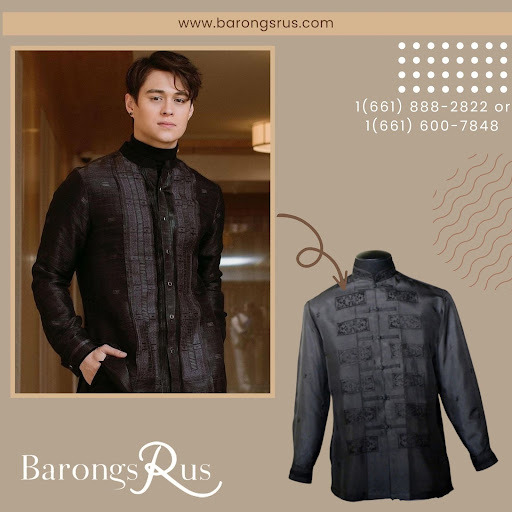
These examples represent just a fraction of the rich variety of traditional costumes in the Philippines, each reflecting the culture, history, and unique heritage of different regions and indigenous communities.
#barongtagalog#philippines#barongs#philippine culture#custommadebarongtagalog#filipinopride#madeinthephilippines#filipinoculture#filipinowedding#pinoy#baro’t saya#basketball#Custommadebarongtagalog#weddingbarong#kimonadress#FilipinianaGown#pineappleindustries
3 notes
·
View notes
Text
The Timeless Elegance of the Barong Tagalog transcends generations, cultures, and evolving fashion trends. This iconic Filipino garment has long been synonymous with grace, respect, and national pride. Its unique blend of simplicity, refinement, and cultural significance makes the Barong Tagalog a symbol of Filipino heritage that continues to captivate and inspire. Let’s explore how the Barong has maintained its elegance through the years and why it remains a powerful emblem of Filipino identity.

1. A Symbol of National Pride and Cultural Identity
The Barong Tagalog is more than just clothing; it is a profound statement of Filipino identity. Over the centuries, this garment has represented the dignity and honor of the Filipino people, worn during the most important occasions, such as weddings, national holidays, and formal gatherings.
Roots in Filipino History: Originally worn during the colonial era as a symbol of defiance and distinction, the Barong was a way for Filipinos to assert their identity in the face of colonial rule. The wearing of the Barong was meant to differentiate the indigenous people from the Spanish colonizers, and over time, it became a symbol of cultural resistance and resilience.
National and Global Symbol: Today, the Barong Tagalog is the national formal wear of the Philippines, recognized worldwide. When worn, it serves as a proud reminder of the country’s history, strength, and cultural pride. It is commonly seen at major events, such as the Philippine Independence Day, Filipino weddings, and state functions.
2. Craftsmanship and Fabric: The Foundation of Elegance
The craftsmanship and the materials used in creating the Barong Tagalog are key to its timeless appeal. Authentic Barongs are made from natural fibers like piña (pineapple fiber) and jusi (banana and silk blend), which contribute to the garment’s luxurious texture and light, breathable quality.
Piña Fabric: One of the most prized materials for making Barongs, piña is derived from the leaves of the pineapple plant. The process of turning these leaves into fabric is labor-intensive and requires skill. The resulting fabric is translucent, crisp, and finely textured, making it ideal for creating a garment that is both formal and comfortable in the tropical climate of the Philippines.
Jusi Fabric: Jusi, another traditional fabric, has a softer texture and more subtle sheen than piña, and is often used for Barongs that require a heavier, more durable feel. Both piña and jusi fabrics, however, have a delicate elegance that enhances the overall look and feel of the Barong Tagalog.
Artisanal Techniques: The careful hand-weaving and embroidery techniques used in crafting the Barong add to its elegance. Each Barong is often embroidered with intricate floral or geometric designs that showcase Filipino artistry. The quality of the craftsmanship, particularly in the hand-embroidery, ensures that each Barong is not only a garment but also a work of art.
3. The Simplicity of the Design
At the heart of the Barong Tagalog’s elegance is its simplicity. Unlike other formal garments that may be complex or ornate, the Barong is defined by its understated beauty. The design is typically minimalist, which allows its fine fabric, meticulous embroidery, and refined tailoring to take center stage.
Loose-Fitting Silhouette: The Barong has a loose, relaxed fit that drapes gracefully on the body. Its untucked style reflects its laid-back yet formal nature, making it ideal for both casual and ceremonial occasions. The absence of excess structure in the design contributes to the overall sense of ease and fluidity, elevating the wearer’s comfort while maintaining an air of sophistication.
Delicate Embroidery: The Barong’s embroidery is often subtle yet intricate. Traditional designs, which draw inspiration from nature, such as vines, flowers, and leaves, create an elegant look without overwhelming the garment. These patterns are a key element in maintaining the timeless charm of the Barong Tagalog, offering beauty without unnecessary embellishment.
Neutral Tones: Traditionally, Barongs come in neutral shades like white, cream, and ivory. These colors convey simplicity, allowing the natural texture of the fabric and the artistry of the embroidery to stand out. The light hues are also appropriate for the tropical climate, making them ideal for both daytime and evening events.
4. Versatility Across Time
Despite its strong historical roots, the Barong Tagalog has proven to be incredibly versatile and adaptable to modern fashion. It’s a piece that works across different occasions, from formal government functions to weddings, cultural events, and even casual gatherings. Over the years, designers have found creative ways to reinvent the Barong, ensuring that it stays relevant in today’s world without losing its essence.
Modern Interpretations: Contemporary Filipino designers have infused the Barong with new life by incorporating modern cuts, fabrics, and designs. From short-sleeve variations to sleek, tailored fits, modern Barongs appeal to younger generations while still respecting traditional craftsmanship. The adaptation of different fabrics like silk and cotton blends has also made the Barong suitable for various climates and more accessible for daily wear.
Global Fashion Influence: High-profile figures, including celebrities and politicians, have worn the Barong to international events, bringing global attention to this iconic piece of Filipino fashion. The Barong has even appeared on global runways, showing that traditional garments can coexist with modern fashion trends.
5. Cultural Significance in the Modern World
As society evolves, the Barong Tagalog remains a cultural touchstone, serving as a link between past and present. Its role in Filipino weddings, state functions, and national celebrations continues to be a vital part of Filipino life, whether in the Philippines or among the diaspora.
Weddings and Celebrations: The Barong is often worn by grooms and male family members at Filipino weddings, where it is viewed as a symbol of dignity and respect. The Barong Tagalog is also a common choice for celebratory occasions such as fiestas, anniversaries, and other milestone events, making it a garment that carries emotional and cultural weight.
A Bridge Between Generations: For many Filipino families, the Barong is an heirloom passed down from one generation to the next. It represents not only the pride of the wearer but also a connection to Filipino heritage and history. Wearing a Barong can be a deeply personal experience, allowing the wearer to honor their ancestors while embracing the future.
6. The Enduring Appeal: A Global Fashion Icon
In today’s world, the Barong Tagalog is no longer confined to Filipino events. It has become a symbol of cultural pride on the global stage. As a representation of Filipino artistry and craftsmanship, the Barong is gaining recognition outside the Philippines as a timeless, elegant garment that blends tradition with modernity.
International Recognition: Whether worn by Filipino dignitaries at state visits or on the international fashion runway, the Barong continues to be an emblem of sophistication and grace. Celebrities and influential figures around the world have worn the Barong to highlight Filipino culture and showcase its timeless elegance.
The Timeless Elegance of the Barong Tagalog reflects not just a garment, but an enduring connection to Filipino heritage and values. From its meticulous craftsmanship to its understated beauty, the Barong Tagalog stands as a testament to the rich cultural traditions of the Philippines. Its elegance, versatility, and cultural significance ensure that it will remain a beloved symbol of Filipino pride for generations to come.
#barongtagalog#philippines#barongs#philippine culture#custommadebarongtagalog#filipinopride#madeinthephilippines#filipinoculture#filipinowedding#pinoy#kimonadress#FilipinoWeddingDress#filipinoamericans#fastion
0 notes
Text
The Barong Tagalog, a traditional Filipino garment, underwent significant transformations throughout the 20th century, adapting to modern trends while maintaining its cultural roots. This evolution was influenced by historical events, social changes, and the shifting dynamics of Filipino identity. From being a symbol of colonial subjugation to a marker of national pride, the Barong Tagalog adapted in response to both local and global fashion trends, making it relevant in the modern age.
Here’s how the Barong Tagalog evolved and adapted to modern trends in the 20th century:
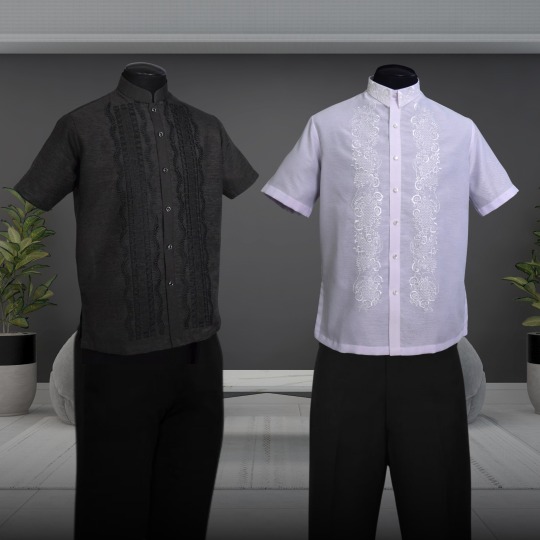
1. Colonial Influence and Early 20th Century: Reinterpretation Post-Revolution
At the turn of the 20th century, after the Philippine Revolution (1896–1898) and the country’s shift from Spanish rule to American colonization, the Barong Tagalog began to gain prominence as a symbol of Filipino resistance and national identity. The garment, which had once been associated with colonial subjugation, became a powerful emblem of Filipino pride and cultural assertion.
Early 1900s (Post-Revolutionary Period):
Return to Tradition: Following the revolution, the Barong Tagalog was reinterpreted by Filipino elites as a garment that expressed nationalism. It was no longer worn solely by the lower classes or as a sign of colonial oppression but became a symbol of the growing Filipino elite’s sense of identity and cultural pride.
American Colonial Influence: During the American colonial period (1898-1946), the Barong Tagalog experienced Western influence. While the American administration encouraged Western-style suits and uniforms, the Barong Tagalog remained important for formal occasions. It was worn by politicians, diplomats, and businessmen in place of the Western suit, creating a distinct Filipino sartorial identity.
2. The Mid-20th Century: The Rise of Piña and Embroidery
The mid-20th century was marked by refinement in the Barong Tagalog’s materials and design, which aligned with broader trends in global fashion. As the Philippines gained independence in 1946, the Barong Tagalog continued to adapt, becoming a more formal and prestigious garment.
1940s–1950s:
Fabric Refinement: Piña (pineapple fiber), long valued for its lightness, texture, and elegance, became the most iconic fabric used for the Barong Tagalog. The intricate hand-embroidery also began to reach new heights in terms of artistry, with Filipino artisans adding detailed, intricate patterns, often reflecting regional styles. These features made the Barong more suited for high-end formal occasions, such as weddings, state functions, and official engagements.
Celebrity and Political Influence: Political figures, such as Manuel Roxas (the first President of the independent Third Republic of the Philippines) and Ferdinand Marcos, wore Barong Tagalog during official events. The Barong Tagalog became the de facto formal wear for Filipino men in positions of power, cementing its place in the national consciousness.
Filipino Men’s Fashion: The Barong Tagalog gradually evolved from a plain, functional garment into something more fashionable and stylish. By the mid-20th century, it was designed with more embellishments like lace trim, delicate embroidered motifs, and sheer, semi-transparent fabrics. These changes reflected the globalized fashion scene, which was growing increasingly focused on detailed craftsmanship and unique designs.
3. 1960s–1970s: Globalization and Cultural Resurgence
In the 1960s and 1970s, the global fashion world became more aware of traditional garments from various cultures, and the Barong Tagalog, as an important symbol of Filipino heritage, started to gain international recognition.
1960s–1970s:
Cultural Nationalism: The rise of cultural nationalism in the Philippines in the 1960s, spurred by figures like Carlos “Botong” Francisco (a prominent Filipino artist) and Nicolás Zafra (a cultural historian), brought the Barong Tagalog back into the public eye as an expression of Filipino identity. This era was marked by efforts to promote Filipino culture through arts, architecture, and fashion. The Barong became a popular garment for formal gatherings, especially after President Ferdinand Marcos issued an executive order in 1975 urging Filipino men to wear the Barong Tagalog on national holidays like Independence Day.
The Barong in International Fashion: As part of the globalization of fashion, the Barong Tagalog began to make its way into international events. The 1960s and 1970s saw Filipino diplomats and leaders sporting the Barong Tagalog at international conferences, state dinners, and even at UN summits, where foreign dignitaries were encouraged to wear the garment. The World Expo in 1964 in New York, where the Philippines was prominently featured, marked an important moment for the Barong Tagalog in the global spotlight.
Changing Fabric and Style: While piña remained the most prestigious fabric, there was also a move towards using other fabrics such as cotton, organza, and rayon. These fabrics made the Barong Tagalog more affordable and accessible to a wider range of Filipinos while still maintaining its traditional elegance. The designs became simpler, though still retaining elements of embroidery, making the Barong more wearable for casual and semi-formal events.
4. 1980s–1990s: The Barong as a Fashion Statement
By the 1980s and 1990s, the Barong Tagalog had fully entered the global fashion mainstream, adapting to the ready-to-wear movement while retaining its identity as a garment for special occasions. The emergence of fashion designers who embraced Filipino craftsmanship also played a key role in modernizing the Barong Tagalog.
1980s–1990s:
Crossover into Fashion: In the late 20th century, Filipino designers such as Rajo Laurel, Cathy Valencia, and Inno Sotto played a crucial role in modernizing the Barong Tagalog. They experimented with fabric choices, introducing organza, silk, and modern synthetics while preserving the garment’s defining sheer, embroidered look. These modern adaptations allowed the Barong Tagalog to remain a fashionable option for contemporary men’s wear while being rooted in tradition.
Global Recognition and Celebrity Endorsement: International figures, including Hollywood celebrities and foreign diplomats, began to wear the Barong Tagalog at formal events. For example, Imelda Marcos, former First Lady of the Philippines, famously wore the Barong Tagalog during high-profile events, and Filipino-American celebrities such as Lou Diamond Phillips began donning the Barong as a celebration of their cultural heritage. This helped elevate the garment’s status on a global scale.
Filipino-American Influence: The growing Filipino diaspora in the United States also contributed to the Barong Tagalog’s adaptation in the 1980s and 1990s. Filipino-Americans began to wear the Barong at weddings, family reunions, and cultural festivals, where it became a fashion statement blending both traditional and contemporary aesthetics.
5. Late 20th Century to Early 21st Century: The Barong Tagalog as a Formal Staple
As the 21st century dawned, the Barong Tagalog evolved further into a formal yet versatile garment. The garment’s continued popularity and its ability to adapt to modern trends ensured that it remained relevant in Filipino society, even as global fashion trends continued to shift.
1990s–2000s:
Barong in Weddings and Formal Functions: The Barong Tagalog became a popular choice for weddings, particularly in Filipino-American communities. Its light fabric and elegant appearance made it an ideal garment for tropical weddings and formal functions in the Philippines, and it became a mainstay in Filipino society for occasions such as national holidays and state dinners.
Global Fashion Recognition: The Barong Tagalog’s integration into the global fashion lexicon continued as international fashion weeks, like those in New York and Paris, saw designers incorporating Filipino elements into their collections. This led to a growing international appreciation for the Barong Tagalog, both as an ethnic garment and as a timeless fashion piece that combines history, art, and modern sophistication.
The Barong Tagalog’s Enduring Appeal
The Barong Tagalog has successfully adapted to modern trends while preserving its cultural significance. From its post-colonial re-emergence as a symbol of Filipino pride to its modern-day adaptation as a staple of formal Filipino fashion, the Barong Tagalog has remained a symbol of the country’s rich heritage and evolving identity.

Through continuous modernization, including fabric innovation, embroidery techniques, and cultural reinterpretations, the Barong Tagalog has become both a formal garment and an international fashion statement, cementing its place in the global fashion scene. Whether worn during state occasions, cultural festivals, or weddings, the Barong Tagalog is a lasting testament to the resilience, craftsmanship, and beauty of Filipino culture.
#barongtagalog#philippines#barongs#philippine culture#custommadebarongtagalog#filipinopride#madeinthephilippines#filipinoculture#filipinowedding#pinoy#FilipinoWeddingDress#Custommadebarongtagalog#filipinoproduct#kimonadress#filipinoamericans#America#trump#united states of america#politics#fastion#fashion#filipinofashion#filipinostyle#filipino#filipina
1 note
·
View note
Text
The quality, craftsmanship and design make this smart Barong Tagalog a head turner.
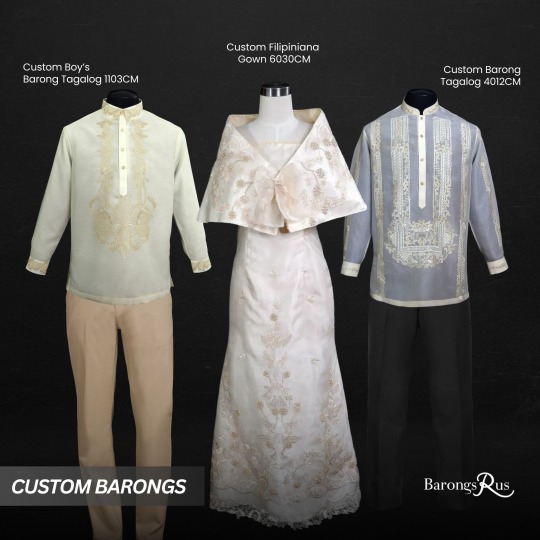
Color: Ivory/Natural
Chinese collar, cuff buttons
Chinese button full-open front
Formal Fit
#barongtagalog#philippines#barongs#philippine culture#custommadebarongtagalog#filipinopride#madeinthephilippines#filipinoculture#filipinowedding#pinoy#PinoyPride#kimonadress#filipinoamericans#America#usa#united states of america#usa politics#trump#trump administration
0 notes
Text
Step into a world where tradition meets contemporary elegance, where the vibrant hues of Burgundy, Black, Fuchsia Pink, and Royal Blue breathe new life into the timeless grace of Women’s Kimonas. In this unique style guide, we unravel the secrets of pairing the perfect bottoms and accessories, creating a tapestry of sophistication and individuality that transcends the boundaries of the ordinary.

Burgundy Kimona: Passionate Elegance
Pairing Recommendation
Neutral Bottoms: Burgundy speaks volumes, making it ideal to pair with neutral bottoms like white or beige skirts or trousers. This allows the vibrant red hue to take center stage.
Accessories:
Gold Accents: Enhance the passionate elegance of the Burgundy Kimona with gold accessories. Opt for gold earrings, a bracelet, or a delicate necklace to add a touch of luxury.

Black Women’s Kimona: Timeless Sophistication
Pairing Recommendation:
Complement with Dark Bottoms: The timeless sophistication of a Black Kimona can be beautifully enhanced by pairing it with dark-colored bottoms like a black A-line skirt.
Accessories:
Silver Details: Silver accessories provide a striking contrast against black. Choose silver earrings, a watch, or a cuff to complement the understated elegance of the Black Women’s Kimona.

Fuchsia Pink Women’s Kimona: Playful Charm
Pairing Recommendation:
White or Navy Bottoms: Fuchsia Pink exudes playful charm and pairs well with white or navy bottoms. A white skirt or navy trousers can balance the vibrancy of the pink.
Accessories:
Pearl Accents: Infuse a touch of sophistication with pearl accessories. Pearl earrings or a delicate pearl necklace can add a refined touch to the playful charm of the Fuchsia Pink Women’s Kimona.

Royal Blue Women’s Kimona: Regal Grace
Pairing Recommendation:
Neutral or Gold Bottoms: Royal Blue exudes regal grace and can be paired with neutral bottoms for a classic look or gold for added opulence.
Sapphire Gems: Enhance the regal aura with sapphire-colored accessories. Sapphire earrings or a gemstone bracelet can complement the rich tones of the Royal Blue Women’s Kimona.
#barong tagalog#philippines#barong#pinoy#philippines fashion#barongtagalog#barongtagalogforwomen#womensfashion#shopping#barongs#kimonadress#kimetsu no yaiba#kimona#kimonas
0 notes
Text

An ideal formal blouse for mother of the bride, black tie or other special occasions. The #kimona style is fully covered in embroidery with a matching panuelo giving this style a touch of real elegance.
#barong tagalog#philippines#barong#pinoy#philippines fashion#barongtagalog#barongtagalogforwomen#womensfashion#shopping#barongs#kimonadress#kimona barong tagalog
0 notes
Text
youtube
In Philippines wedding, Barong Tagalog always makes an engaging appearance that has gained more popularity and preference with the groom’s attire. Philippine is famous for its wide-ranging market research on consumer products, commercial industries,
#barongtagalog#philippines#barongs#philippine culture#custommadebarongtagalog#filipinopride#madeinthephilippines#filipinoculture#filipinowedding#pinoy#philippineculture#womensbarong#kimonadress#Youtube
1 note
·
View note
Text


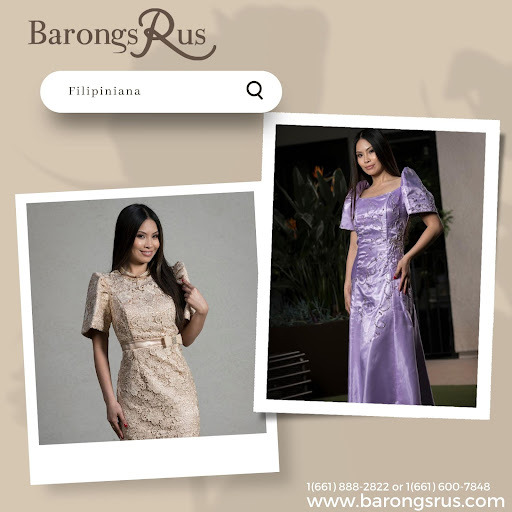
Barong Tagalog is offering extremely stylish Filipiniana gowns at affordable prices and wide variety of fine Barong Tagalog for men. Visit our website for more options.
#barong tagalog#philippines#barong#pinoy#philippines fashion#barongtagalog#barongtagalogforwomen#womensfashion#shopping#barongs#kimonadress#FilipinoWeddingDress#womengown#fashion
0 notes
Text

We're super excited to share some fabulous moments of our favorite celebrities rocking the timeless and elegant Filipiniana! From red carpet-events to special occasions, these stars have shown the beauty of our traditional Filipino attire. Check out this iconic look!
#barong tagalog#philippines#barong#pinoy#philippines fashion#barongtagalog#barongtagalogforwomen#womensfashion#shopping#barongs#philippineculture#philippinewomen#kimonadress#womengown#fashion
0 notes
Text

At Barongs R Us, we believe that the true beauty of a Barong Tagalog lies in the exceptional quality of its fabric. That's why we're proud to offer a range of premium fabrics, each with its own unique characteristics and charm, to create the perfect Barong for you. Explore our luxurious fabric options and experience the pinnacle of Filipino craftsmanship!
#barong tagalog#philippines#barong#pinoy#philippines fashion#barongtagalog#barongtagalogforwomen#womensfashion#shopping#barongs#philippinecostume#pinoyshoppingonline#filipinostoresonline#kimonadress#philippineculture
0 notes
Link
The barong tagalog is the traditional formal men’s attire in the Philippines. The attire’s delicate-looking features belie the fact that the garment holds up quite well in very strenuous circumstances –which most barong wearers are quite familiar with. What the barong is not, however, is the fact that not knowing how to clean it properly can lead to damaging it. In the Philippines, most dry cleaning services are quite adept at cleaning barongs –which ironically don’t involve the typical dry cleaning processes. But if you’re outside of the Philippines and need to have the barong washed, what should you do?

Does it Even Need a Wash?
This is the first real question a barong wearer should ask after having worn a barong. Now, in the Philippines, the answer is a very easy yes. The basic rule of thumb is this: if the barong has been exposed to sweat, then yes, it needs a wash. For anything else, it depends. This is because the Philippines has a tropical climate (worsened by the effects of climate change) that causes the typical barong wearer to sweat –and no, the camisa is rarely enough to prevent the barong from being affected. On the other hand, taking the barong to a location with very cold weather means that sweat is hardly a problem or occurrence at all. So it is possible to not need cleaning. Of course, remember that exposure to vapors and odors can affect the barong. Smoke from cooked food, cigarettes, and other sources can be absorbed by the fabric –so give the barong a quick smell check as well.

So what about other types of dirt and stains? Firstly, aside from sweat, the skin naturally secretes oils as well.
Areas not protected by the camisa (such as the collar area around the neck and the arms) need to be checked.
If only small parts of the barong need cleaning, then the only thing one needs to have is some spot cleaning.
How to Clean a Barong

If you only need to do spot cleaning: soak up the affected area by using a mild detergent and water, and then let it sit for a while (be sure to avoid the temptation of trying to rub stains out the moment you notice them as this is likely to force dirt deeper into the fabric). After about half an hour of soaking, try to clean the area manually by rubbing it very lightly. More often than not, most stains should come off pretty easily. If they don’t come off during the first wash, soak (or soak longer) and then clean it again.
Of course, there are times when an entire barong needs to be washed. The process is pretty much the same (soak in mild detergent), but leave it soaking overnight, rub it lightly the following day and let the water run off (if you decide to rinse it off under running water, make sure to set the pressure to very low). Soaking in warm water is recommended, but it is not strictly necessary. Be sure to just let the water run off and then hang the barong to dry –avoid wringing it as this can cause several wrinkling and worse, possibly damaging the fabric.
Understanding why You Should Skip the Dry Cleaners

In general, most dry cleaning services use specialized chemical mixes instead of water to clean clothes. That may be a bit of an oversimplification (they also use specialized machines to gently agitate the fabric and dirt), but the point is that the typical dry cleaning processes can potentially damage the fabrics used for barongs (pina/pineapple fabrics can be particularly susceptible from either the chemicals or the mechanical actions). Simply put, a cleaner unfamiliar with the barong is more likely to damage it. This is why maintaining the barong yourself is a good idea.
Steamers and Irons

A steamer is a great way to maintain the upkeep of a barong. You can do without it, but the benefits it provides are hard to be without. Primarily, helps you do two very important things. First off: sanitizing. Nothing kills bacteria faster than a blast of hot steam, which in turn, eliminates most odors. Second: it removes small wrinkles. Ironing a barong to make it smooth takes a little more effort than just steaming it, and when you only have to deal with a few minor creases, this is a faster and better option to use. More often than not, spot cleaning and then steaming a barong is enough to keep it fresh and ready even after some use.
A steamer does more than just sanitizing and smoothing your barong, it also keeps it moist. The Philippines is humid all year round, so most people are not aware that jusi fabric (and pina) can be affected by very dry weather conditions. If you’re planning to wear a barong in either Canada or in America, be sure to steam the barong lightly once every few weeks even when it is not in use in order to maintain the strength of the fabric –otherwise, it may turn brittle.
Despite the local term “gusot mayaman” (a rich person’s wrinkled wear), a barong that has been fully washed will need to be ironed smooth. To iron a barong, make sure to place the cloth on a smooth, flat, and soft surface (such as a very firm pillow, or a flat mattress), then place a thin piece of cloth over it (a shirt or a thick handkerchief will suffice) so the iron will not directly touch the delicate fabric. Place the iron on low heat and avoid the buttons when smoothing things out. Once smoothened out, be sure to store the barong using a clothes hanger in order to maintain the form factor of the shoulders and to keep it from wrinkling.
#womensbarong#barongs#barongtagalog#philippine culture#filipinofashion#pinoy#philipinofastion#womensfashion#kidsfashion#madeinthephilippines#philippines#modernkimona#kimonadress#philippinecostume#CustomFilipinianaGown#Custommadebarongtagalog
5 notes
·
View notes
Link

A Filipiniana dress exudes elegance, even more so when the wearer feels confident in wearing it. Our Miss Universe 2018 Catriona Gray has been garnering attention with her exuding confidence every time she wears any type of traditional dress in any event that she is in. As the beauty queen is mostly seen garbed in locally woven outfits, she has certainly made a memorable appearance to the following events.
#philippines#shopping#barong tagalog#barong#kimonadress#kimona barong tagalog#yannis philippakis#womensfashion#ba
0 notes